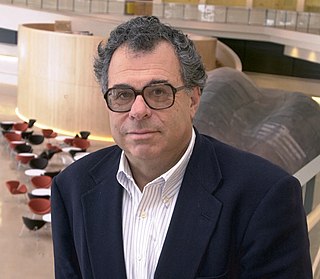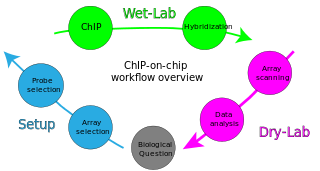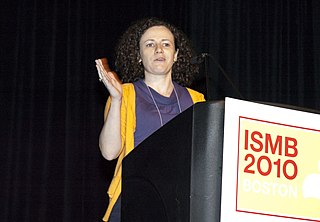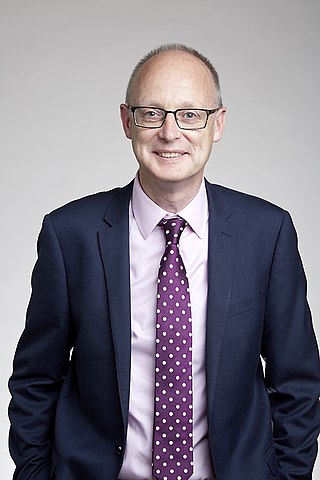Related Research Articles

Yeasts are eukaryotic, single-celled microorganisms classified as members of the fungus kingdom. The first yeast originated hundreds of millions of years ago, and at least 1,500 species are currently recognized. They are estimated to constitute 1% of all described fungal species.

Genomics is an interdisciplinary field of molecular biology focusing on the structure, function, evolution, mapping, and editing of genomes. A genome is an organism's complete set of DNA, including all of its genes as well as its hierarchical, three-dimensional structural configuration. In contrast to genetics, which refers to the study of individual genes and their roles in inheritance, genomics aims at the collective characterization and quantification of all of an organism's genes, their interrelations and influence on the organism. Genes may direct the production of proteins with the assistance of enzymes and messenger molecules. In turn, proteins make up body structures such as organs and tissues as well as control chemical reactions and carry signals between cells. Genomics also involves the sequencing and analysis of genomes through uses of high throughput DNA sequencing and bioinformatics to assemble and analyze the function and structure of entire genomes. Advances in genomics have triggered a revolution in discovery-based research and systems biology to facilitate understanding of even the most complex biological systems such as the brain.

Schizosaccharomyces pombe, also called "fission yeast", is a species of yeast used in traditional brewing and as a model organism in molecular and cell biology. It is a unicellular eukaryote, whose cells are rod-shaped. Cells typically measure 3 to 4 micrometres in diameter and 7 to 14 micrometres in length. Its genome, which is approximately 14.1 million base pairs, is estimated to contain 4,970 protein-coding genes and at least 450 non-coding RNAs.
Gene duplication is a major mechanism through which new genetic material is generated during molecular evolution. It can be defined as any duplication of a region of DNA that contains a gene. Gene duplications can arise as products of several types of errors in DNA replication and repair machinery as well as through fortuitous capture by selfish genetic elements. Common sources of gene duplications include ectopic recombination, retrotransposition event, aneuploidy, polyploidy, and replication slippage.
Minimum information about a microarray experiment (MIAME) is a standard created by the FGED Society for reporting microarray experiments.

Michael Bruce Eisen is an American computational biologist and the former editor-in-chief of the journal eLife. He is a professor of genetics, genomics and development at University of California, Berkeley. He is a leading advocate of open access scientific publishing and is co-founder of Public Library of Science (PLOS). In 2018, Eisen announced his candidacy U.S. Senate from California as an Independent, though he failed to qualify for the ballot.

Patrick O'Reilly Brown is an American scientist and businessman who is the founder of Impossible Foods Inc. and professor emeritus in the department of biochemistry at Stanford University. Brown is co-founder of the Public Library of Science, inventor of the DNA microarray, and a former investigator at Howard Hughes Medical Institute.

David Botstein is an American biologist who is the chief scientific officer of Calico. He was the director of the Lewis-Sigler Institute for Integrative Genomics at Princeton University from 2003 to 2013, where he remains an Anthony B. Evnin Professor of Genomics.

In food processing, fermentation is the conversion of carbohydrates to alcohol or organic acids using microorganisms—yeasts or bacteria—under anaerobic (oxygen-free) conditions. Fermentation usually implies that the action of microorganisms is desired. The science of fermentation is known as zymology or zymurgy.

ChIP-on-chip is a technology that combines chromatin immunoprecipitation ('ChIP') with DNA microarray ("chip"). Like regular ChIP, ChIP-on-chip is used to investigate interactions between proteins and DNA in vivo. Specifically, it allows the identification of the cistrome, the sum of binding sites, for DNA-binding proteins on a genome-wide basis. Whole-genome analysis can be performed to determine the locations of binding sites for almost any protein of interest. As the name of the technique suggests, such proteins are generally those operating in the context of chromatin. The most prominent representatives of this class are transcription factors, replication-related proteins, like origin recognition complex protein (ORC), histones, their variants, and histone modifications.
Gene Expression Omnibus (GEO) is a database for gene expression profiling and RNA methylation profiling managed by the National Center for Biotechnology Information (NCBI). These high-throughput screening genomics data are derived from microarray or RNA-Seq experimental data. These data need to conform to the minimum information about a microarray experiment (MIAME) format.
Mark Alden Schena is an American biochemist and president of a public life sciences health care company.

Olga G. Troyanskaya is an American scientist. She is Professor in the Department of Computer Science and the Lewis-Sigler Institute for Integrative Genomics at Princeton University and the Deputy Director for Genomics at the Flatiron Institute's Center for Computational Biology in New York City. She studies protein function and interactions in biological pathways by analyzing genomic data using computational tools.
Ronald Wayne "Ron" Davis is professor of biochemistry and genetics, and director of the Stanford Genome Technology Center at Stanford University. Davis is a researcher in biotechnology and molecular genetics, particularly active in human and yeast genomics and the development of new technologies in genomics, with over 30 biotechnology patents. In 2013, it was said of Davis that "A substantial number of the major genetic advances of the past 20 years can be traced back to Davis in some way." Since his son fell severely ill with myalgic encephalomyelitis/chronic fatigue syndrome Davis has focused his research efforts into the illness.

Atul J. Butte is a biomedical informatics researcher and biotechnology entrepreneur. He is currently the Priscilla Chan and Mark Zuckerberg Distinguished Professor at the University of California, San Francisco. Since April 2015, Butte has serves as inaugural director of UCSF's Bakar Computational Health Sciences Institute.
Michael P. Snyder is an American genomicist and the Stanford B. Ascherman Professor, and since 2009, chair of genetics and director of genomics and personalized medicine at Stanford University. He is the former director of the Yale Center for Genomics and Proteomics. He was elected to the American Academy of Arts and Sciences in 2015. During his tenure as chair of the department at Stanford, U.S. News & World Report has ranked Stanford University first or tied for first in genetics, genomics and bioinformatics.
Transcriptomics technologies are the techniques used to study an organism's transcriptome, the sum of all of its RNA transcripts. The information content of an organism is recorded in the DNA of its genome and expressed through transcription. Here, mRNA serves as a transient intermediary molecule in the information network, whilst non-coding RNAs perform additional diverse functions. A transcriptome captures a snapshot in time of the total transcripts present in a cell. Transcriptomics technologies provide a broad account of which cellular processes are active and which are dormant. A major challenge in molecular biology is to understand how a single genome gives rise to a variety of cells. Another is how gene expression is regulated.

Kenneth Henry Wolfe is an Irish geneticist and professor of genomic evolution at University College Dublin (UCD), Ireland.

Theresa Gaasterland is an American politician and scientist. She is a Professor of Computational Biology and Genomics and Director of the Scripps Genome Center at the University of California, San Diego (UCSD). She was elected a Fellow of the International Society for Computational Biology (ISCB) in 2018 for outstanding contributions to the fields of computational biology and bioinformatics.
Daniel S. Fisher is an American theoretical physicist working in statistical physics.
References
- ↑ "Gavin Sherlock". Stanford University. Retrieved 14 January 2019.
- ↑ Shawna Williams (6 October 2014). "Genetic data crunching achieves another milestone" . Retrieved 14 January 2019.
- ↑ Krista Conger (26 February 2012). "In vino veritas: Promiscuous yeast hook up in wine-making vats, study shows". Stanford Medicine. Retrieved 14 January 2019.